As a seasoned hunter, I’ve learned that precision is the key to a successful hunt. You can have the best rifle in the world, but without the right optic, you’re just hoping for a lucky shot. Fact: Studies show that hunters using advanced optics, like prism scopes, have a 35% higher chance of hitting their target on the first try compared to those using traditional riflescopes.
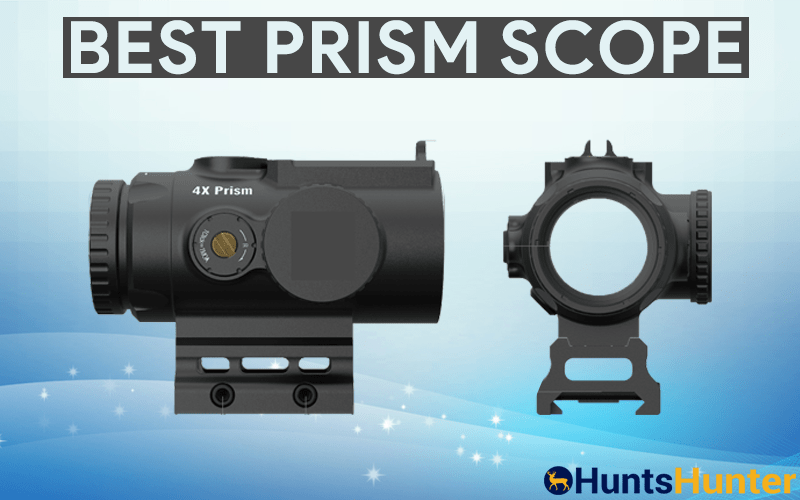
Prism scopes, also known as prismatic scopes, are changing the game when it comes to fast and accurate targeting, especially in close to mid-range hunting. With compact designs, crystal-clear reticles, and a no-nonsense approach to fast target acquisition, these scopes are ideal for hunters navigating varied terrain. In this article, I’ll dive into my top picks for the best prism scopes, helping you find the perfect optic to boost your accuracy and confidence in the field.
Overview of The Best Prism Scopes
1. CVLIFE 4×32 Prism Tactical Rifle Scope Red, Green & Blue Illuminated Reticle
Our Pick
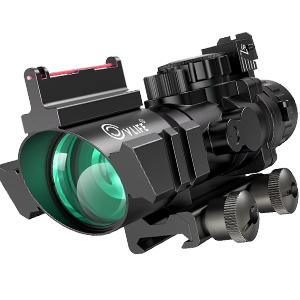
⚙ Main Specifications
- Magnification: 4x
- Reticle: Red/Green/Blue
- Objective Lens Dia.: 32mm
- Field of View: 36ft @ 100yds
- Eye Relief: 3.6 inches
- Weight: 15.9 Ounces
- Warranty: 1 year
2. UUQ Prism 4×32 Red/Green/Blue Triple Illuminated Rapid Range Prism Scope
Best Budget
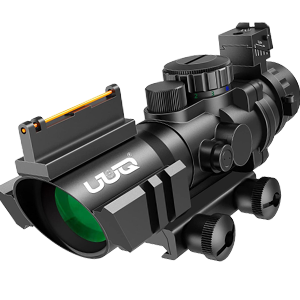
⚙ Main Specifications
- Magnification: 4x
- Reticle: Red/Green/Blue
- Objective Lens Dia.: 32mm
- Field of View: 36ft @ 100yds
- Eye Relief: 3.6 inches
- Weight: 17 Ounces
- Warranty: 1 year
3. CRUSHUNT4x32 Scope Red Fiber Prism Scope
Lightweight
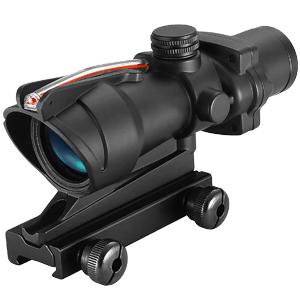
⚙ Main Specifications
- Magnification: 4x
- Reticle: Red
- Objective Lens Dia.: 32mm
- Mounting Type: Picatinny Mount
- Eye Relief: 3.5 inches
- Weight: 15 Ounces
- Warranty: 2 year
4. Monstrum P330-B Marksman 3X Prism Scope
Premuim One
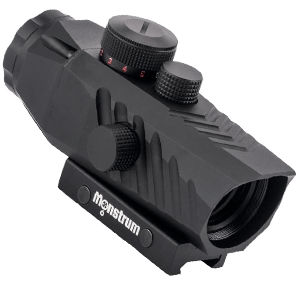
⚙ Main Specifications
- Magnification: 3x
- Reticle: Circle Dot, BDC, or MX1
- Objective Lens Dia.: 30mm
- Scope Range: Close Range, 200+ Yards
- Eye Relief: 3.5 inches
- Weight: 17 Ounces
- Warranty: 1 year
5. Vortex Optics Spitfire 1x Prism Scope – DRT Reticle
Quality Product
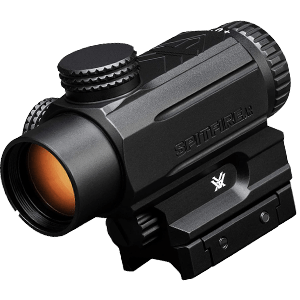
⚙ Main Specifications
- Magnification: 4x
- Reticle: DRT Reticle
- Objective Lens Dia.: 32mm
- Field of View: 79ft @ 100yds
- Eye Relief: 3.8 inches
- Weight: 11.2 Ounces
- Warranty: Unlimited, unconditional lifetime warranty
6. Burris Tactical Prism Sight with Illuminated 3-Color
Great Sight

⚙ Main Specifications
- Magnification: 1x
- Reticle: Red/Green/Black
- Objective Lens Dia.: 32mm
- Field of View: 80ft @ 100yds
- Eye Relief: 3.7 inches
- Weight: 21 Ounces
- Warranty: Manufacturer
7. Primary Arms SLX 3x32mm Gen III Prism Scope
Simple & versatile
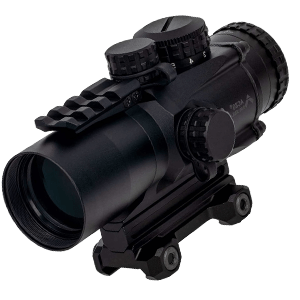
⚙ Main Specifications
- Magnification: 3x
- Reticle: Full Red
- Objective Lens Dia.: 32mm
- Field of View: 31.5ft @ 100yds
- Eye Relief: 2.72in – 2.95in
- Weight: 1.77 Pounds
- Warranty: 1 year
What is a Prism Scope?
A prism scope (also known as a prism sight or optic) is a compact, fixed-magnification optic designed for rifles, shotguns, and other firearms. Instead of relying on multiple lenses like traditional scopes, prism scopes use a prism system to focus light, making them more compact, durable, and lightweight.
Benefits of a Prism Scope
1. Prism-Based Optical Design:
Prism scopes use prisms to focus and magnify the image, which allows for a shorter tube length than traditional scopes. This makes them easier to mount and more portable, a key advantage for hunters moving through rugged terrain.
2. Etched Reticle:
Unlike red dot sights, which require batteries to project a reticle, prism scopes have an etched reticle. This means the reticle is engraved into the glass and remains visible without power. If the battery fails or you’re in low-light conditions, the reticle is still clear and reliable.
3. Fixed Magnification:
Prism scopes typically come with fixed magnification options (such as 1x, 3x, or 5x). Fixed magnification ensures a bright, distortion-free sight picture, which is ideal for short to medium-range hunting and allows for quick target acquisition—crucial when tracking fast-moving game like deer or wild boar.
4. Compact and Durable:
Thanks to the prism design, these scopes are more compact and rugged. They are built to withstand harsh environmental conditions like rain, dust, and accidental impacts, making them suitable for tactical use, hunting, and competitive shooting.
5. Improved Clarity for Astigmatism:
Hunters with astigmatism often face issues with red dot sights appearing blurry or distorted. Prism scopes provide a clearer reticle without the “starburst” effect, offering sharper aim and increased accuracy for those with vision impairments.
6. Illuminated Reticle for Low-Light Use:
Many prism scopes feature illuminated reticles, improving visibility during low-light conditions like dawn or dusk—peak times for hunting. This is a valuable asset for hunters tracking game in challenging lighting environments.
7. Good Eye Relief:
Prism scopes often provide adequate eye relief, allowing the shooter to maintain a comfortable distance from the scope while still achieving a clear, sharp sight picture. This can be particularly helpful when firing from various shooting positions.
Why Hunters Use Prism Scopes:
- Fast Target Acquisition: Fixed magnification and a clear reticle help hunters quickly lock onto targets, particularly useful for fast-moving animals.
- Reliable in All Conditions: The etched reticle remains visible in low-light or if the battery dies, making it a dependable choice during long hunts.
- Portability: Compact and lightweight, prism scopes reduce the burden on hunters who travel long distances or navigate difficult terrain.
Things to Consider While Buying a Prism Scope for Hunting
When choosing a prism scope for a hunting rifle, there are several key factors to consider to ensure it meets your needs.
1. Magnification Options
Prism scopes generally come with fixed magnification, unlike variable scopes that allow you to adjust the zoom. Therefore, it’s important to choose the right magnification based on your hunting environment:
1. Low Magnification (1x–2x):
- Ideal for short to medium distances (up to 200 yards).
- Offers faster target acquisition and a wider field of view, which is essential for quick shots in close quarters or dense areas, such as forests.
- If you hunt in environments where targets may suddenly appear, a 1x or 2x prism scope is a good option. The Primary Arms 1x micro prism is recommended for such close-range scenarios, as it balances between quick target acquisition and effective shooting up to 400 yards for trained shooters.
2. Mid Magnification (3x–5x):
- For medium-range hunting (200–600 yards), a 3x to 5x magnification is versatile, allowing you to scan for targets at a distance while still maintaining a relatively quick aiming speed.
- The Vortex 3x Spitfire and Primary Arms 3x micro prism are popular choices in this category for their balance of range and shooting speed.
- 5x magnification scopes, such as the Vortex 5x Gen 2 Spitfire, extend your effective range further, up to 1000 yards for recreational shooting, while still allowing you to shoot efficiently within 250 yards. However, higher magnification tends to slow down target acquisition, so they are better suited for situations where precision and distance are more important than speed.
3. High Magnification (4x–6x):
- Best for long-range hunting (400 yards and beyond).
- 4x scopes, such as the Trijicon ACOG TA-31, can be used up to 800 yards, making them excellent for wide-open terrains where long-distance shots are common.
- 6x magnifiers, like the Vortex Micro 6x, are typically used for precision shots at 300+ yards but can also be useful for scanning large open fields for game. They excel in spotting distant targets and ensuring accurate hits but can slow you down in closer engagements.
2. Field of View (FOV)
The field of view refers to how much of the surrounding area you can see through the scope at a given distance, usually measured in feet at 100 yards.
- A larger field of view is critical when scanning large areas, such as in wide-open hunting fields. It allows you to see more of your surroundings, spot movement, and track game.
- A smaller field of view, often associated with higher magnification, focuses your vision but limits peripheral awareness, which can be a disadvantage in dynamic hunting situations.
The video introduces the concept of normalized field of view, which multiplies the field of view by the magnification. This gives a more accurate understanding of how large the sight picture will feel at a given magnification. For example, a 1x prism scope may have a large technical field of view, but much of it could be obscured by the scope body.
Recommendation:
If you need to scan for game or targets at longer distances, aim for a scope with a larger effective field of view. A normalized field of view above 105 is ideal, but closer to 130–150 provides an excellent sight picture.
3. Eye Relief
Eye relief refers to how far your eye can be from the scope and still see the full sight picture. In hunting, this is important for comfort and flexibility, especially when you’re in unusual shooting positions or need to make quick adjustments.
- Shorter eye relief (common in higher magnification scopes) might lead to “scope bite” (where the scope hits your eye due to recoil), especially when using rifles with strong recoil like the SR25 or LR308.
- Longer eye relief allows for more flexibility and reduces the risk of scope bite, but you may sacrifice some field of view.
In the video, the Primary Arms 1x micro prism is highlighted for its longer and more flexible eye relief, making it suitable for close-range hunting with some medium-range capability.
Recommendation:
For most hunting purposes, an eye relief of 2 to 2.7 inches offers the best balance between flexibility and comfort. Shorter eye relief can be tolerable but is risky with high-recoil rifles.
4. Weight and Size
Weight and size are crucial for hunters, especially those who may need to cover long distances or navigate rough terrain. A heavier scope can affect mobility and endurance, while a lighter scope enhances maneuverability but may come with trade-offs in durability or optical quality.
- Lighter scopes (such as 1x and 2x prisms) are easier to handle, making them ideal for quick movement in dense areas.
- Heavier, high-magnification scopes like the Vortex 5x Spitfire can offer superior range and precision, but they are bulkier, which may slow you down during long hunts.
Recommendation:
Choose a scope that balances weight and magnification according to your hunting style. If you’ll be doing a lot of hiking, a lighter optic is preferable, but if you prioritize long-range shots, you might need to accept the additional weight for better performance.
5. Additional Features (Target Scanning and Piggyback Capabilities)
- Target scanning is essential for hunting when you’re trying to spot camouflaged animals in the distance. Higher magnification (3x and above) helps with long-distance scanning but can slow down target acquisition for close-up game.
- Piggyback capabilities refer to adding additional sighting tools like a red dot on top of a higher-magnification scope. This is useful if you need to quickly switch between close-range and long-range shooting.
The video mentions the Vortex 5x Spitfire, which can be paired with a red dot, allowing the user to engage in both close- and long-distance shots without needing to switch optics.
Recommendation:
If your hunting involves both close- and long-range engagements, look for scopes that offer piggyback options or consider using an offset red dot alongside your prism scope for versatility.
Overview While Choosing a Prism Scope
When selecting a prism scope for a hunting rifle, consider:
- Magnification: Choose based on your hunting distance and target size.
- Field of View: A larger FOV improves situational awareness, especially for scanning targets.
- Eye Relief: Ensure comfortable and safe shooting, especially with high-recoil rifles.
- Weight and Size: Balance portability with your need for range and precision.
- Additional Features: Consider piggyback options and your need for target scanning at different distances.
Leave a Reply